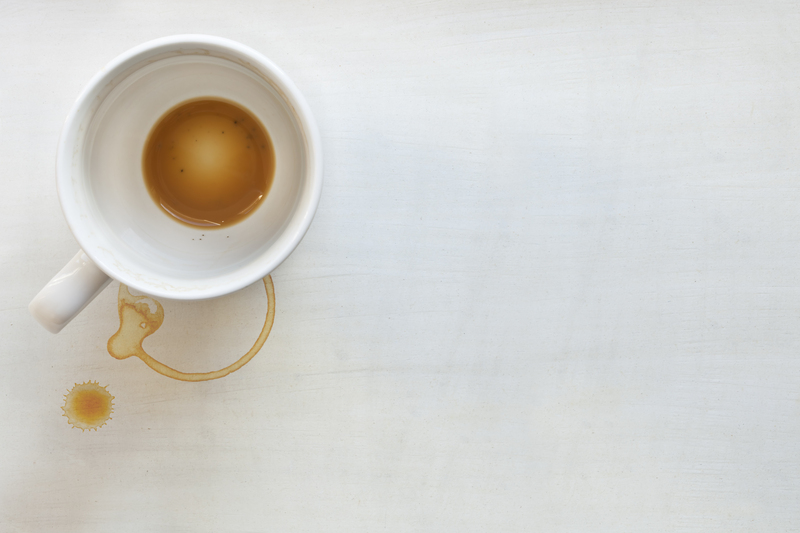Ultimate Guide to a Sparkling Clean Burnt Stovetop
Posted on 22/05/2025
Ultimate Guide to a Sparkling Clean Burnt Stovetop
Is your stovetop looking worse for wear, covered with burnt-on food and stubborn stains? Whether you're a passionate home chef or a casual cook, a sparkling clean stovetop not only keeps your kitchen looking beautiful but also ensures better hygiene and safety. This comprehensive guide will teach you everything you need to know to restore your burnt stovetop to its original shine, regardless of whether you have a glass, ceramic, or traditional coil stove.
Why Keeping Your Stovetop Clean Matters
A burnt stovetop is not only unsightly--it can also harbor bacteria and affect the performance of your appliances. Food residue and grease can ignite, posing a fire hazard, and can negatively impact the flavor of your dishes. Regular cleaning extends the life of your stovetop and makes cooking a more enjoyable experience. In this guide, we walk you through the best methods, expert tips, frequently asked questions, and more to ensure your stovetop stays immaculate.

Understanding Your Stovetop Type
Before you start cleaning, it's important to identify your stovetop type. Each variety--glass, ceramic, gas, or electric--demands specific care. Recognizing your stove's material means you'll choose methods and cleaning agents that won't cause damage and deliver the best results.
Common Stovetop Types
- Glass stovetops - Sleek but prone to scratches; needs gentle, non-abrasive cleaners.
- Ceramic stovetops - Similar care as glass, especially sensitive to abrasives.
- Gas stovetops - Feature removable grates and burners; tolerate stronger scrubbing but require extra attention to small parts.
- Electric coil stoves - With removable coils and drip pans, these often house more burnt-on residue beneath the heating element.
Essential Supplies for Cleaning a Burnt Stovetop
Gather your cleaning toolkit before you begin. Here's what you'll need for a deep-clean and a shining stovetop:
- Baking soda
- White vinegar
- Lemon juice
- Dish soap (preferably grease-cutting)
- Microfiber cloths or soft sponges
- Plastic scraper (for glass or ceramic tops)
- Old toothbrush
- Gloves
- Paper towels
Optional, but helpful:
- Razor blade (for glass stovetops)
- Commercial stovetop cleaner
- Magic eraser
Step-by-Step: How to Clean a Burnt Stovetop
Let's break down the process, step by step, so that you can easily tackle any level of burnt-on residue and grime. Patience and a systematic approach are key!
Step 1: Let Your Stovetop Cool Completely
Before beginning any cleaning, make sure your stovetop is cool to the touch to prevent burns or injury. This is particularly important with glass and ceramic tops, as cleaning agents applied to hot surfaces can bake stains in further.
Step 2: Remove Removable Parts
- Gas stoves: Lift off grates and burner covers. Soak them in a sink filled with hot, soapy water.
- Electric stoves: Unplug coils and remove drip pans if possible. Soak pans in soapy water.
- Glass/ceramic: No removable parts, so focus on the surface.
Let these components soak while you address the stovetop's main surface and burnt-on stains.
Step 3: Wipe Loose Debris
Use a damp microfiber cloth or paper towel to gently wipe up any loose crumbs, burnt food bits, or splatters from the stovetop. This makes the next steps more effective.
Step 4: Apply a Cleaning Paste
Baking soda and water create a powerful, non-abrasive paste:
- Mix equal parts baking soda and water in a bowl to form a paste with the consistency of toothpaste.
- Spread the paste generously over burned spots and stained areas.
- Let it sit for at least 15 minutes--it will loosen even the most stubborn carbonized food.
For tougher burnt stains, add a splash of white vinegar to the paste for fizzing action.
Step 5: Gently Scrub the Surface
Using a soft sponge or microfiber cloth, rub the paste in a circular motion over the burnt areas. For tricky crevices and tight spots, use an old toothbrush.
- Glass or ceramic stovetops: Never use steel wool or harsh abrasives, as they can cause scratches and permanent damage.
- Gas and coil burners: A non-scratch scouring pad gives a deeper clean to metal parts.
Step 6: Scrape Away Stubborn Burnt-On Food
For especially persistent buildup, gently use a plastic scraper at a low angle to lift off the burnt residue. On glass stovetops, a razor blade scraper (used carefully and flat against the surface) works wonders for removing tough, caramelized spots.
Step 7: Rinse and Repeat as Needed
Wipe away all cleaning paste with a damp cloth. For lingering stains, repeat the baking soda paste treatment or switch to a specialized stovetop cleaner if your stove's manufacturer recommends one.
Step 8: Tackle Greasy Stains with Vinegar or Lemon
- Spray a solution of equal parts white vinegar and water onto the surface. Let it sit for a minute, then wipe clean. Vinegar effortlessly cuts through stubborn grease and leaves a streak-free shine.
- Try fresh lemon juice for a natural, deodorizing alternative--especially good for cutting through residual odors.
Step 9: Clean Removable Components
Return to your soaked grates, burner covers, or drip pans. Use a sponge or brush to scrub off loosened grime. For burnt spots, sprinkle with baking soda and add a dash of vinegar, scrubbing with a brush for extra power.
Step 10: Final Polish for a Sparkling Finish
- Buff the dry surface with a clean, dry microfiber cloth to restore sparkle and remove streaks.
- Replace all parts, ensuring they are dry and securely positioned before using your stove again.
Best DIY and Store-Bought Solutions for Burnt Stovetops
Top DIY Burnt Stovetop Cleaners
- Baking soda + vinegar paste: Excellent for breaking down carbon and grease.
- Lemon and salt scrub: Natural, effective, and leaves a fresh scent behind.
- Dish soap and hot water: Ideal for everyday maintenance and lightly burnt areas.
Recommended Store-Bought Cleaners
- Cerama Bryte - Specially formulated for glass and ceramic stovetops.
- Bar Keepers Friend - Good for tough spots (avoid on delicate glass or ceramic).
- Weiman Cooktop Cleaner - Gentle yet effective for shine and polish.
- Magic Eraser - For quick removal of light stains and discoloration.
Frequently Asked Questions About Cleaning Burnt Stovetops
How can I prevent my stovetop from burning in the future?
- Wipe spills immediately after cooking--hot sugar or grease can quickly carbonize if left unattended.
- Use softer utensils and avoid dragging heavy pots across delicate surfaces.
- Clean your stovetop regularly to prevent buildup and minimize tough stains.
Can I use oven cleaner on my stovetop?
- Most oven cleaners are too aggressive for stovetop surfaces and may cause discoloration or damage, especially to glass, ceramic, and coated parts.
How do I remove burnt milk from my glass stovetop?
- Let the surface cool, then apply a thick baking soda paste. Cover with a damp cloth and let sit for 30 minutes. Scrub gently, using a plastic scraper if needed.
What should I avoid when cleaning my stovetop?
- Steel wool, harsh abrasives, or abrasive powders--these scratch and wear down your stove's surface.
- Excessive water--especially near burners or electric elements, to avoid electrical hazard.
- Unapproved chemicals that can void your warranty or cause damage.
Expert Tips for Maintaining a Clean, Sparkling Stovetop
- Make it a habit to wipe your stovetop daily with a microfiber cloth after it cools down.
- Deep clean once per week with baking soda paste or a gentle commercial cleaner to stay ahead of buildup.
- Keep a spray bottle of diluted white vinegar handy to quickly neutralize grease and odors.
- Soak removable parts, like burner grates or drip pans, in hot dish soap every two weeks for a hassle-free clean.
- Address spills and splatters as soon as possible--the quicker you clean, the less scrubbing later!
- Use protective liners or mats under burners (approved for your stove type) for easy future cleanup.

When to Call a Professional for Your Stovetop
Despite your best efforts, some stains and issues may require an expert. If you notice:
- Persistent burner ignition problems on gas stoves
- Cracks or deep scratches on glass or ceramic surfaces
- Electrical malfunctions or exposed wiring on electric stovetops
Contact a qualified appliance technician for safe, effective repairs and deep cleaning services.
Conclusion: Enjoy a Sparkling Clean Burnt Stovetop Every Day
Maintaining a sparkling clean stovetop may seem like a daunting chore, but with the right approach and regular upkeep, your kitchen can shine all year round. A pristine cooktop not only elevates the look of your home but also supports healthy, delicious meals for you and your family.
For more kitchen cleaning tips and guides, bookmark this page and share it with friends who want to master the art of restoring a burnt stovetop. Remember, with a bit of know-how, the cleanup is easy--and the results are absolutely rewarding.





